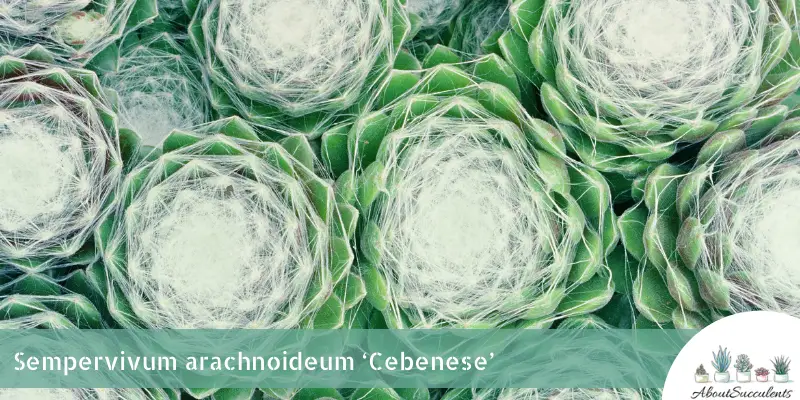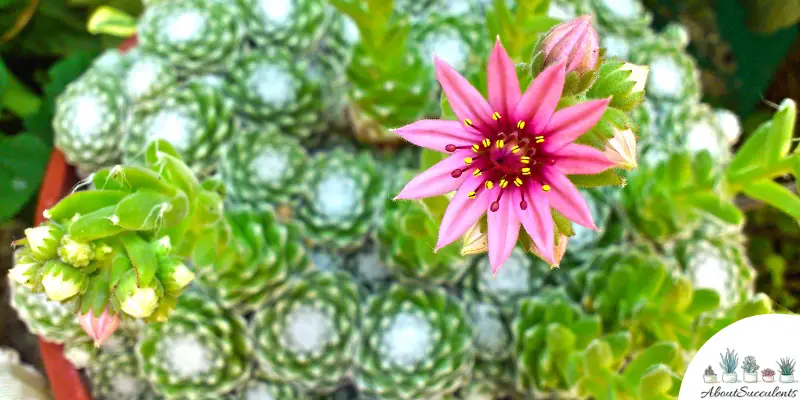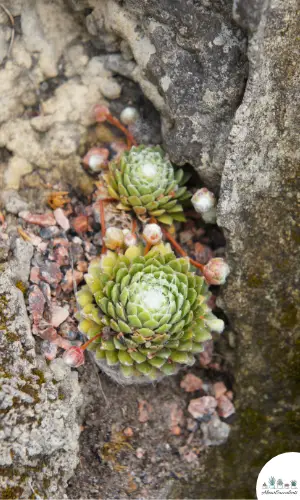
Sempervivum Arachnoideum is a succulent that has a fascinating appearance and will surely captivate and enchant your guests.
If the term ‘arachnoideum’ has you thinking the name has to do with spiders, you are absolutely right! Translated, the name Sempervivum Arachnoideum means ‘always alive spider web’.
This evergreen perennial has many common names most of which are related to spiders. These common names are Cobweb Houseleek, Spider Web Hens and Chicks, Cobweb Sedum, and Cebenese.
The connection with spiders has to do with the look of Cobweb Houseleek. It forms thick, fleshy rosettes with a reddish-purple color and is adorned with white fibers on top that look like cobwebs.
The rosettes measure 2.54cm to 3.81cm (1” to 1.5”) in diameter and can spread out to 20.32cm to 30.48cm (8” to 12”) wide. A fully grown Cebenese is quite small, reaching only a height of about 7.5cm (3”).
From mid to late summer, Cobweb Sedum actively blooms. You’ll be greeted by star-shaped, pink-colored flowers growing on rosettes. The flowers measure 1.27cm (0.50”) in diameter.
In some instances, you might see yellow-colored flowers instead of pink ones.
Sempervivum Arachnoideum can be found in the Alps, Carpathians, and the Apennines and is a member of the Crassulaceae family.
General Information
Also known as: Cobweb Houseleek, Spider Web Hens and Chicks, Cobweb Sedum, Cebenese.
Plant Family: Crassulaceae
Origin: Alps, Carpathians, and the Apennines.
Height: 7.5cm (3”)
Exposure: Full to partial sunlight for up to 6 hours.
Water Needs: Give the soil a thorough soaking and then water again only when the soil has gone completely dry.
Soil Type: Well-draining sandy soil with perlite or pumice added for better drainage.
Soil pH: 6 to 8
How to Grow and Care for Sempervivum Arachnoideum ( Cebenese )

Sempervivum Arachnoideum is a fast-growing succulent but is also monocarpic.
This means the variety of succulents dies within a short amount of time – but will leave you with many offsets or pups so you can continue growing the species in your home or outdoor garden.
Cebenese is an easy type of succulent to grow and care for. You can say that Cobweb Sedum is a no-frills, no-fuss succulent to care for and is ideal for those with busy lifestyles.
Cobweb Houseleek won’t give you problems provided you follow the guidelines discussed below.
Sunlight
Sempervivum Arachnoideum will thrive when exposed to either full or partial sun. The important thing to remember is that Cebenese needs to receive 4 to 6 hours of sunlight per day.
If you want to grow Cobweb Sedum as an addition to your expanding succulent garden, make sure it’s situated in an area that gets the prescribed amount of morning or late afternoon sunlight.
One important thing to consider is that Spider Web Hens and Chicks doesn’t take to frosty conditions very well. The lowest temperature Cebenese can tolerate is -29° C (-20° F).
If your area experiences freezing temperatures that fall below this level, it would be best to plant Cobweb Houseleek in a movable pot.
Sunlight remains important when Sempervivum Arachnoideum is grown as a houseplant. Make sure the pot is located near a window that gets 4 to 6 hours of partial sunlight every day.
Watering

Succulents store water in their leaves and stems that make them resilient to drought and survive long periods without water.
Sempervivum Arachnoideum still needs water to extract nutrients from the soil but only when the soil has gone absolutely dry. Giving the soil water while there’s moisture will expose the roots to the risk of rotting.
You can use a Hygrometer to test the moisture content of the soil. If you don’t have this tool, a stick will do.
Simply insert the stick 1-2” into the soil. Pull it out and assess the moisture level. If the end of the stick feels dry, you can give Cebenese water.
An important reminder when watering is to water from below and not above. Always water the soil and not the plant.
Watering the plant will keep it moist longer. Remember, Cebenese stores water in its leaves and stems. Also, if Cobweb Sedum has a fungal infection, the excess water from the leaves could contaminate the plants around it.
The best way to water a succulent plant is the soak and dry method. This means give the soil a thorough drenching when watering. If Spider Web Hens and Chicks is in a pot, excess water will be leaking out of the drain holes.
Remove the water that has collected in the tray underneath the pot to keep the roots from sitting in water for an extended period.
Pot and Soil
Drying out the soil as fast and quickly as possible is key to the growth and health of Sempervivum Arachnoideum.
For this reason, choose a pot made of unglazed ceramic or terracotta for Cebenese. Ceramic and terracotta are ideal because these materials allow moisture to escape from the soil and along the sides of the pot.
Lastly, make sure the pot has drain holes at the bottom to enable excess water to leak through. If you can find a pot that includes a mesh net, that would be great as the net will keep the soil from coming out.
Cobweb Houseleeks is a durable succulent and can thrive in poor-quality soil. To help it grow better, plant Cobweb Sedum in well-draining sandy soil and add ingredients to improve drainage such as perlite or pumice.
How To Propagate Sempervivum Arachnoideum ( Cebenese )
Sempervivum Arachnoideum makes it easy for you to propagate the species by giving you plenty of offsets or pups that grow from the main plant.
Method 1 – Offsets
Step 1: Gently pull out or cut off the offsets with a sharpened and sterilized knife or garden scissors.
Step 2: Allow the offsets to rest in a warm area for 1 to 2 days so they can dry out and develop hard calluses.
Step 3: Once the offsets have enough calluses, plant them in a pot filled with well-draining soil.
Step 4: Water the soil only when it has gone completely dry.
Frequently Asked Questions
Is Sempervivum Arachnoideum ( Cebenese ) Toxic to Cats and Dogs?
Sempervivum Arachnoideum is not toxic to your pet as the succulent is not listed on the website of the American Society for the Prevention of Cruelty to Animals (ASPCA) as a succulent plant that can be harmful to your cats and dogs.
Why Is My Sempervivum Arachnoideum ( Cebenese ) Dying?
Sempervivum Arachnoideum is resilient to changes in temperature but like other succulent plants, its health can be seriously affected by overwatering.
Cobweb Houseleek attracts butterflies but it also entices pests to make it their home because of its sap. These pests can carry fungi that can affect the health of your plant.
If you notice Spider Web Hens and Chicks getting weaker or perhaps dying, you can still save its life but you have to act fast.
Overwatering
Overwatering or giving Sempervivum Arachnoideum water too frequently when its soil is still moist can cause root rot.
If the roots of Cobweb Houseleek remain immersed in a moist environment for a long time, its cells will start to swell up and eventually rupture. This condition leaves the succulent exposed to a fungal infection that can spread rapidly.
Telltale signs that a fungal infection is taking place are the appearance of black spots or a change in the color of Spider Web Hens and Chicks’ leaves and stems. The leaves will feel mushy and limp and might present a yellowish, blackish color.
When you see these signs, reach out for a pair of garden scissors or a sharp knife. Disinfect these tools first by rubbing the sharp edges with 70% isopropyl alcohol. Cut away all of the discolored parts of the plant.
Now, do the same for the roots.
Remove Sempervivum Arachnoideum from the soil and inspect the roots closely. Cut off all of the roots that have rotted and place Cobweb Houseleek in a warm area to dry out.
The final step is to prepare Spider Hens and Chicks’ new home!
Fill out a ceramic or terracotta pot with fresh sandy soil and add pumice or perlite to improve the level of drainage. Replant Sempervivum Arachnoideum and strictly observe its watering schedule from hereon.
Pest Infestation
Vine Weevils, mealybugs, aphids, and scale insects will try to find their way inside Sempervivum Arachnoideum. Your succulent is an ideal home for these pests because they can have all the sap they want.
Cobweb Houseleek will grow weak when it’s drained of nutritious sap and become susceptible to infections. Mealybugs will also leave a white, powdery substance on the leaves that could lead to a fungal infection.
These pests are so small that you won’t see them with the naked eye. Take the necessary precautions and spray the succulent with neem oil or a systemic insecticide to keep it free of pests.
If you see substances on the leaves, wipe these off with a cotton swab dipped in diluted 70% isopropyl alcohol.
Yes, Sempervivum Arachnoideum produces small, star-shaped, and pink-colored flowers from mid to late summer.
Last Updated on June 9, 2022 by Sofia Lara